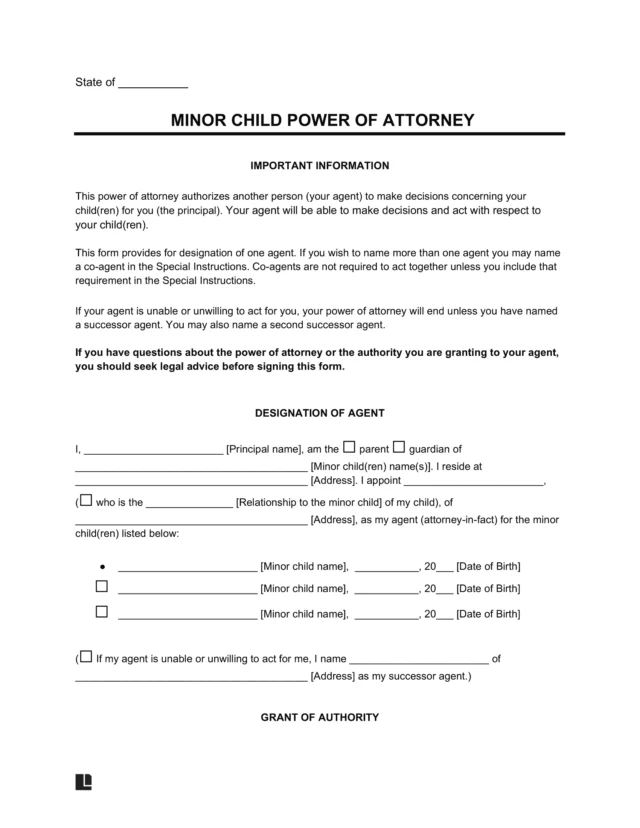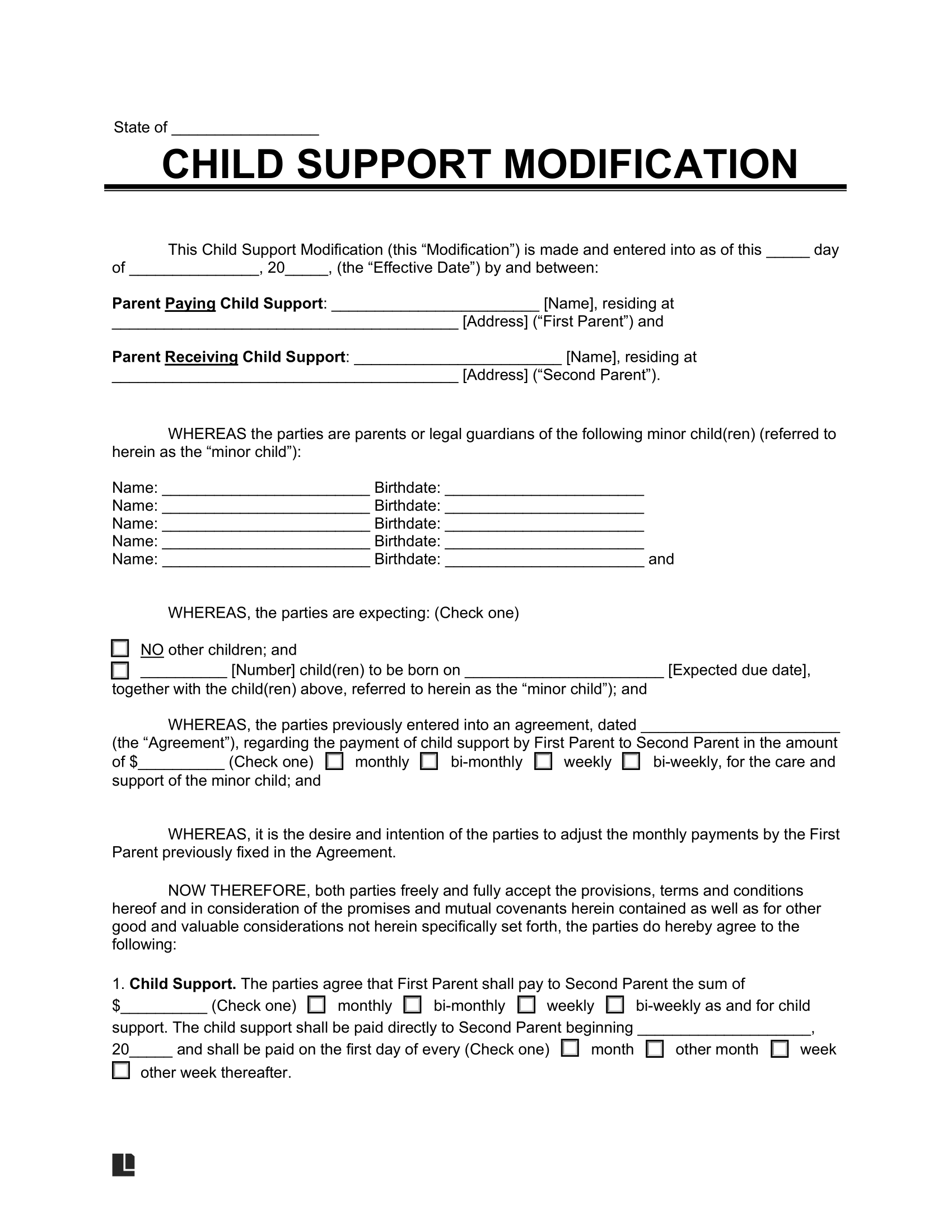What Is a Child Support Modification Form?
A child support modification form is a legal document parents use to change an existing order when circumstances shift. It explains why the current terms no longer fit.
Depending on the state or tribe, requests go through the child support agency or the court. To move forward, the parent filing provides income details and supporting proof. This may include pay stubs, tax returns, or a job change notice.
If both parents agree, they can start following the new terms right away, even before official approval, but it is important to make sure that the official agreement makes note of the change. This makes it easier to adjust support quickly when life changes.
When to Use a Child Support Modification Form
Reviews of existing child support orders are allowed every three years, but they can also happen sooner if major circumstances change. Common reasons for filing a child support modification form include:
- The paying parent can no longer meet obligations due to job loss, disability, or incarceration.
- The receiving parent learns the paying parent is earning more and seeks higher contributions.
- The child has new expenses, such as medical costs or tuition.
- Custody or visitation arrangements change, shifting how much time the child spends with each parent.
Families receiving Temporary Assistance for Needy Families (TANF) don’t need to file a request because the state automatically reviews orders every three years. In non-TANF cases, the parent or custodian needs to take the step themselves.
For incarcerated parents, filing right away is critical. Debt continues to build while they are in custody and cannot be reduced later. To improve the chances of approval, it helps to provide a strong reason for the request along with clear documentation.
If you need to establish child support before filing a modification, consider using a child support demand letter template.
State Laws for Child Support Modification
Child support modification works under both federal and state rules. At the federal level, the Office of Child Support Services (OCSS) sets the guidelines. From there, state and tribal agencies carry out most reviews, while courts step in for cases outside agency control. How states handle modifications can look very different:
- Some states only allow a review after a set amount of time has passed.
- Others let parents file as soon as there’s a significant change in circumstances.
- Documentation requirements vary, with some states asking for detailed financial records and others focusing on custody changes.
Because the rules are not the same everywhere, parents need to check the laws in their own state. The ACF interactive map gives an overview of each state’s process. For a fuller picture, look at your state’s child support modification laws to see how the process works where you live.
| State | When Is Child Support Modification Appropriate | Statute |
|---|---|---|
| Alabama | At least a 10% difference between the new calculation under the state's guidelines and the current support order is required and/or the party seeking a modification of child support must plead and prove that there has occurred a material change in circumstances that is substantial and continuing since the last order of child support. | Ala. R. Jud. Admin. 32(A)(3) |
| Alaska | A material change of circumstances is required. At least a 15% difference between the new calculation under the state's guidelines and the current support order is presumed to be a material change in circumstances. | Alaska R. Civ. P. 90.3 |
| Arizona | A showing of a substantial and continuing change in circumstances is required. At least a 15% difference between the new calculation under the state's guidelines and the current support order will be considered evidence of a substantial and continuing change in circumstances. | AZ Rev Stat § 25-327 and 25-503 |
| Arkansas | A material change in circumstances is required. At least a 20% increase or decrease in either parent's income will constitute a material change in circumstances. Other changes in the parties’ circumstances may also entitle a party to a modification of child support. | AR Code § 9-14-107 |
| California | Must be based on a substantial change in circumstances since the last order. If an amount is stipulated by the parties, no change of circumstances is necessary. As a general rule, modification may be granted for a 20% change in the order or $50, whichever is less. | Cal. Fam. Code §§ 4064 and 4065 |
How to Write a Child Support Modification Form
A child support modification form needs to clearly show why the current order should change and how the new terms will apply. Every section ties back to child support, so it’s important to be specific and accurate.
- Parents’ names: List the full legal names of both parents so the request applies to the right people.
- Children’s details: Include each child’s full name and birth date. This links the modification directly to them. Include your custody or visitation schedule with the child or children at issue as child support may be based on the amount of custodial time that you have.
- Original order: Reference the original child support order. Note the date, the paying parent, the current amount, and how often payments are made.
- Financial statement: Provide updated income, wages, and expenses. Back it up with proof, such as pay stubs, tax returns, or benefit statements, to show why the change is needed.
- New terms: State the requested support amount, the payment schedule, and the start date. Be sure the terms follow state guidelines. List the substantial or significant changes that have led to you seeking a modification.
- Tuition costs: Specify if either parent will cover tuition or school-related expenses and how payments will work.
- Medical coverage: Indicate which parent provides health insurance and note any deductibles, premiums, or co-pays.
- Payment method: Say whether payments go through the state depository (required in many states) or directly between parents if allowed.
- Extra provisions: Add agreements on extracurriculars, childcare, or transportation so expectations are clear.
- Law and disputes: Identify which state’s child support law applies. Note if disputes will go to mediation and who pays attorney fees.
- Witnesses/notary: Some states require a witness or notary. Check the rules and follow them to avoid delays.
- Effective date: Enter the date the modification starts and file on time. If you don’t, the agency may use outdated earnings, which could raise the payment.
Once you’ve filled in every detail, double-check the form before submitting. A solid child support modification form backed by clear financial records gives you the strongest chance of having the changes approved quickly.
If your request changes custody or parenting time, attach a parenting plan to set schedules, exchanges, holidays, and decision-making.
Child Support Modification Form Sample
The sample below shows exactly how a child support modification form should look, from parent and child details to new terms. When ready, download the template in Word or PDF and customize it to your needs.









